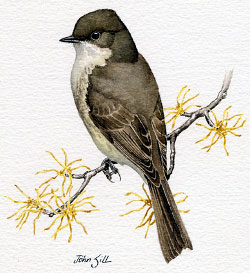Find a Bird - BBA1
Breeding Bird Atlas 1 Species Accounts
Eastern Phoebe
Sayornis phoebe
Egg Dates
April 24 to August 15
Number of Broods
two

The Eastern Phoebe ranges widely throughout the eastern United States and southern Canada and during the breeding season is widespread throughout Massachusetts, although it is less common on Cape Cod and the Islands. The bird is most often seen perched on small branches from which it makes quick flights to pick off flying insects, followed by a return to the same spot. When perched, phoebes are characterized by the constant downward flipping of their tail.
Phoebes appear in a wide variety of habitats from open country, woods, and farmland to suburbia. Proximity to running water is preferred but not essential. Phoebes are among the earliest passerine migrants, appearing in their breeding areas in late March and early April. From the time the male arrives until the female returns about two weeks later, he sings constantly, both to attract a mate and to establish a nesting territory of several acres in extent. This area is large enough to preclude much conflict with neighbors. If necessary, both the male and female will defend by song and chase, but seldom is there physical contact.
During courtship, the female phoebe frequently appears quite aggressive to the male, keeping him at a distance. The song is a rasping vocalization of the fee-bee name, the second syllable alternately rising and falling. After pairing and the initiation of nesting, the male’s singing gradually diminishes. Preparation for a second nesting includes renewed singing. The female can sing but seldom does. Both sexes use sharp chip notes to keep in contact.
Following courtship, the female builds a cup-shaped nest of mud and moss and lines it with grass, hair, and feathers. She builds on a flat surface that ranges from a rock shelf under a cliff overhang to beams inside buildings or eaves, above lights or shutters, under bridges, or in culverts. The birds frequently nest very close to human activity and seem not to be particularly disturbed by it. In Massachusetts, nests may be completed as early as April 2 (BOEM). The locations of 45 state nests were as follows: bridge (22 nests), house (7 nests), barn (4 nests), shed (3 nests), garage (2 nests), unspecified building (4 nests), rock ledge (3 nests) (CNR, Meservey). Heights of 20 of these nests ranged from 4 to 10 feet, with an average of nearly 7 feet (CNR).
There are usually five eggs (range three to eight) in a clutch. Clutch sizes for 26 Massachusetts nests were as follows: two eggs, possibly an incomplete clutch (1 nest); three eggs (2 nests); four eggs (5 nests); five eggs (17 nests); six eggs (1 nest) (CNR, DKW). The eggs are either completely white or occasionally have a few light brown spots at the large end. Incubation is solely by the female, and she leaves the nest only for short periods. During such an absence, the nest may be parasitized by a cowbird. After an average incubation of 16 days, the nestlings remain in the nest for 15 to 18 days. Nestlings have been recorded in Massachusetts from May 11 to July 26 (CNR, Nice 1933). Brood sizes for 15 state nests were as follows: one young (1 nest), three young (3 nests), four young (4 nests), five young (7 nests) (CNR, Kroodsma). Heavy arthropod parasite infestation, which is common, may be severe enough to kill the nestlings.
Both parents feed the young in the nest and for several weeks following fledging, although the young start some independent feeding soon after leaving the nest. If the female starts to lay a second clutch of eggs within a few days after the fledging of the first brood, the male alone feeds the immatures until they are independent. The diet is primarily a variety of insects captured on the wing or plucked from vegetation or the water’s surface while the bird hovers. Fledged young have been observed in the state from late May until early August (CNR, Meservey), but the egg dates indicate that the ranges for both nestlings and fledglings are greater than the records show. The young remain in the general area of the territory until the end of the summer, although they are apart from the parent birds.
Two broods are reared each season, and the birds will renest readily. While there are reports that three broods may be raised on occasion, this has not been well documented in the Commonwealth. Nest failures due to weather, predation, insect parasites, and human disturbance are common. The late egg dates probably represent renesting attempts. The outcomes of 20 state nesting attempts were as follows: young fledged (6 nests), failed (7 nests), unknown outcome (7 nests) (CNR).
Phoebes linger in the fall, departing during late September to mid-October in their fall migration to the southeastern United States and Mexico. After this, only stragglers are reported. During their winter stay in the south, the birds remain solitary and mostly silent.
Map Legend and Data Summary
Atlas 1 data collected from 1975-1979


Note: common throughout most of the state wherever suitable nesting structures exist
Mary Baird



